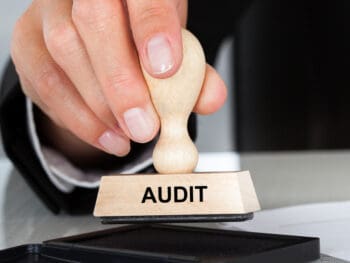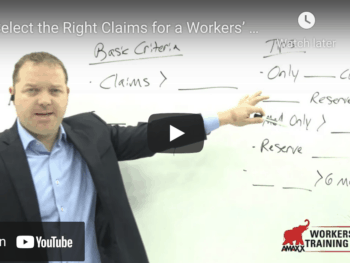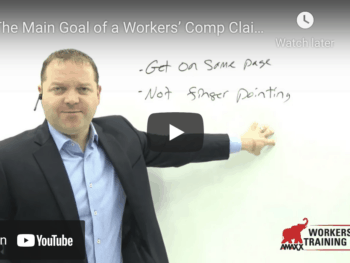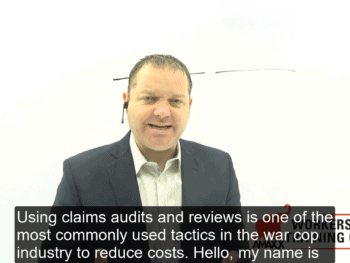
By the end of the claims audit’s first day, the claims auditor knew what was driving the cost of the workers’ comp claims sky high. There was no investigation by the adjusters of any of the claims when they were reported to the third party administrator (TPA). In each claim, the first file note was, “Called employer; they do not question the claim.” That was it. There was no other investigation on the claim.
A proper claims investigation entails various aspects, far more than confirming with the employer that the claim was reported! The claims investigation has to be much more than asking the employer if the employer is suspicious of the claim.
Click Link to Access Free PDF Download
“Workers’ Comp Claims Review Checklist: 9 Must-Have, Serious-Impact Elements”
Start Investigation Based on Facts & Circumstances Reported by Employer
Each claim is unique. Sure, there will be a lot of similarities with previous claim files, but the facts and circumstances surrounding the injury will vary. The investigation should be started based on the facts and circumstances reported by the employer. It is the claims adjuster’s responsibility to review all the information about the claim to both weed out the claims that should not be paid and to control and manage the claims that are owed.
It is a commonly accepted premise in the insurance industry that good claims handling leads to good results and poor claims handling leads to poor results. This applies to both the claim of questionable authenticity and the valid claim. If a valid claim has poor claims handling, the claim cost will be higher. The first step in the process of having a successful claims management program is a good investigation of each claim.
Start Investigation Immediately
Immediately upon assignment of the new workers’ comp claim the adjuster should begin the investigation. Immediately (meaning, in the first few minutes) is not always possible. But the longer the adjuster delays to start an investigation, the poorer the results. If the TPA’s published best practices state same-day contact – that is good. If best practices state 24-hour contact – that is acceptable. If best practices have no time limit for making contact with the employee, employer and medical provider, or if the time limit is longer than 24 hours, the TPA is putting their own interest and what is easy and best for themselves ahead of what is best for the employer.
The first investigation step is to contact the employer to review all known information about the claim. The mistake the adjusters made in the claims audit noted above was contacting the wrong person at the employer. They were discussing the claim with the workers’ comp coordinator for the employer. The person(s) the adjusters should have been contacting was the injured employee’s direct supervisor and co-workers who saw the accident. If no one saw the accident, then the adjuster should contact the first person the employee advised of the accident. The reason for this is to establish exactly what happened, the nature of the injury, and the extent of the injury.
It is better for the adjuster to discuss the accident with the employer first, but that is not always possible. If the adjuster is unable to reach the employer, the adjuster should still make immediate contact with the employee. The quality of the adjuster’s contact with the employee is key. The contact needs to be thorough with the adjuster learning as much as can be learned about the claimant and the accident. If there is any question about the validity of the accident, or there is the possibility of subrogation, or the injury is severe, the initial interview should be in the form of a recorded statement from the employee.
19 Points to Cover in a Proper Workers’ Comp Claim Investigation:
- The details/facts of how the accident happened.
- The names of aall co-workerswho witnessed the accident.
- The nature of the employee’s disability.
- The extent of the injury and all body parts that were injured.
- Has the employee previously had an injury to the body part(s) involved in this accident?
- A review of all prior injuries – work, vehicular, recreational, etc.
- Verification of all information on the employer’s first report of injury.
- Confirmation of all information to support subrogation.
- A description of the employee’s job duties.
- The employee’s job title.
- The equipment or tools involved in the work at the time of the injury.
- The experience level of the employee – how long on the job, and prior experience in the same type of work with other employers.
- Confirmation of lost time.
- The availability of modified duty work.
- The identification of all medical providers for the injury.
- The type of medical care being provided.
- The nature of any pre-existing medical conditions – obesity, diabetes, etc.
- Any concurrent treatment with pre-existing medical conditions.
- The identification of pre-injury medical providers if pertinent to the claim.
At the conclusion of the interview with the employee, the adjuster should discuss the indemnity benefits that will be provided, the employer’s desire to get the employee back to work when the employee is medically capable of doing so, and the need for the adjuster and the employee to stay in contact. The adjuster should arrange for the employee to call the adjuster after each medical appointment to provide an update on the status of the medical treatment and the employee’s work status.
Assess Injured Workers’ Attitude
Contact with the employee should give the adjuster insight into the claimant’s attitude toward:
- The employer.
- The medical treatment.
- The early return to work.
- The benefits provided by workers comp.
The relationship between the adjuster and the employee should not be an adversarial one, but one of mutual cooperation where the adjuster does whatever can be done to facilitate the employee’s recovery and return to work.
Timely Investigation Allows Adjuster to Better Manage Claim
A timely initial investigation allows the adjuster to better manage the claim. By establishing contact with the employee and discussing thoroughly the aspects of the claim, the adjuster significantly reduces the likelihood of attorney involvement, the treatment of unrelated medical conditions, the inclination of the employee to take extra time off work, and the likelihood of co-workers thinking it is easy to “take a vacation on comp.”
A proper investigation allows the adjuster to manage the many facets of the claim as it develops. It allows the adjuster to make an early and proper determination of compensability and to pay benefits quickly and correctly. It facilitates the timely involvement of medical management. And, the proper investigation leads to much lower claims cost.

Author Rebecca Shafer, JD, President of Amaxx Risk Solutions, Inc. is a national expert in the field of workers compensation. She is a writer, speaker, and publisher. Her expertise is working with employers to reduce workers compensation costs, and her clients include airlines, healthcare, printing/publishing, pharmaceuticals, retail, hospitality, and manufacturing. She is the co-author of the #1 selling book on cost containment, Workers Compensation Management Program: Reduce Costs 20% to 50%. Contact:.
Contact: RShafer@ReduceYourWorkersComp.com.
Workers’ Comp Roundup Blog: https://blog.reduceyourworkerscomp.com/
©2018 Amaxx LLC. All rights reserved under International Copyright Law.
Do not use this information without independent verification. All state laws vary. You should consult with your insurance broker, attorney, or qualified professional.
















